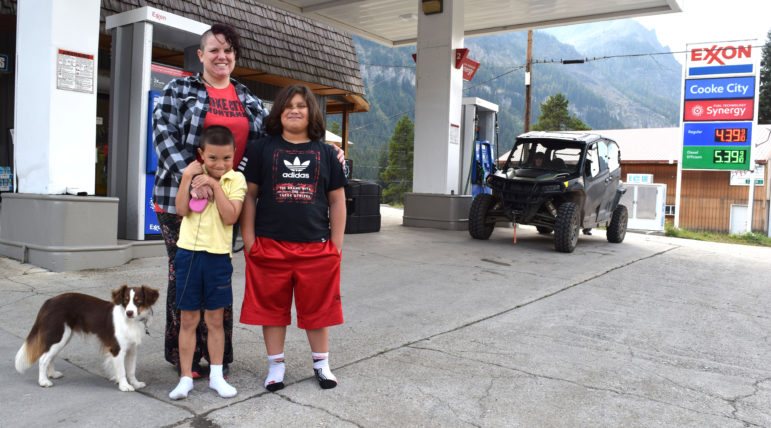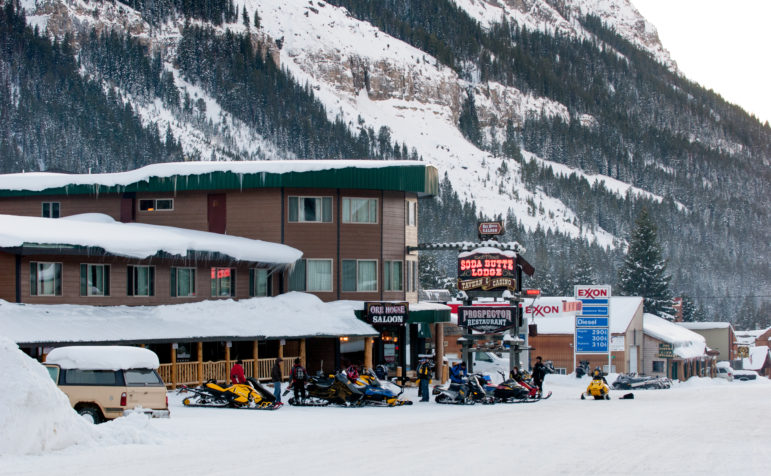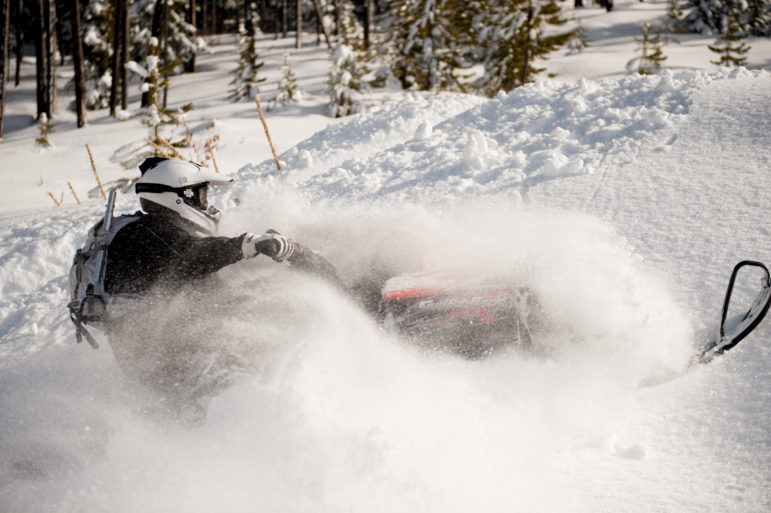CODY, Wyo. — Living in a remote mountain community can come with unique challenges. But that’s something Joelle Passerello knew in 2019 when she moved to Cooke City, Mont., a tourist town literally at the end of the road.
Passerello, a single mother of two, manages a gas station in the isolated mountain town located just outside the Northeast Entrance to Yellowstone National Park. In the winter, the only way in or out of town is a 55-mile trek through the park’s northern range to Gardiner, Mont. The Northeast Entrance Road dead-ends at the eastern edge of Cooke City, blocked by an eight-mile section of snow-covered U.S. Highway 212 that remains unplowed for the season.
During the summer, Passarello shops at the nearest Walmart, in Cody, and travels there or to Billings, Mont. for health care at the U.S. Department of Veterans Affairs. But this time of year, the unplowed “plug,” as locals call it, means her follow-up appointments after an October surgery require the Air Force veteran to make a 550-mile round trip.
“I knew there were going to be issues, and I would have to plan accordingly,” said Passarello, who has to pull her kids from school and rent a hotel room for such trips. “But I never thought it would be this complicated.”

Joelle Passerello manages a gas station in Cooke City, Mont., where she lives with her sons Xavier, left, and Charlie, along with their dog, Tippie. Passerello is among a majority of residents in the area seeking to plow a section of U.S. Highway 212 that blocks her access to nearby shopping and medical care in Wyoming and Montana. (Yellowstone Gate photo by Ruffin Prevost)
For decades, the National Park Service has plowed the Northeast Entrance Road through the Lamar Valley, connecting Gardiner and nearby park headquarters in Mammoth Hot Springs, Wyo. to the tiny Montana outposts of Silver Gate and Cooke City, which lie just outside the park’s Northeast Entrance.
The Wyoming Department of Transportation and Park County, Wyo. have traditionally plowed the Chief Joseph Scenic Highway and a section of U.S. Highway 212 to Pilot Creek, a little more than four miles south of the Montana border, and just over eight miles southeast from Cooke City. That has allowed snowmobilers coming from Wyoming to use a parking area at Pilot Creek for parking trucks, trailers and campers. The eight-mile section of unplowed road lets them sled to Cooke City and easily access a network of backcountry trails along the way.
But record floods in June washed out wide sections of roads in Yellowstone, including the Northeast Entrance Road. Those closures cut off park visitor access to Cooke City from the west until October, wrecking the local tourist economy for the season. It also left residents feeling vulnerable to future unforeseen incidents, and sparked a grassroots community movement to “plow the plug” in winter, a goal pursued for decades by advocates in Montana and Wyoming.
Proponents of plowing say it will increase winter tourism in the region by allowing auto travel from Gardiner to Cody. It would boost wolf watching, skiing, snowshoeing, ice climbing and other Cooke City area activities unavailable to those arriving from the Wyoming side, except by snowmobile. They also cite health and safety issues related to long delays for emergency services as a key concern, as well as a desire to use a public highway year-round.
After the June floods, advocates of plowing formed the Park Access Recommendation Committee (PARC), pushing to plow the plug. They have gathered cost estimates and met with public officials, and later this month will ask Park County Montana Commissioners to formally request that Gov. Greg Gianforte plow the road.
Not so simple
That request is one step in the process, but the problem is not so simple. The plug straddles the Montana/Wyoming border, crossing through two counties and two national forests. Plowing it would require a new funding and cooperation between a wide range of local, state and federal agencies.
Not to mention addressing concerns from snowmobile riders.
While not all sledders oppose plowing the plug, a vocal minority are either against plowing under any circumstances, or they want to first see additional new trail infrastructure developed.
“This has been a wonderful trail for over 40 years,” said Bert Miller of Cody, a member of Protect Our Plug (POP), a group formed in opposition to plowing, and in response to PARC’s efforts.
“It brings in a lot of revenue to Cooke City, and if it was looked at further at being plowed, we would first insist on having new parking areas and a new trail put in” that would parallel the plowed road section, said Miller, a director of the Cody Country Snowmobile Association.
Miller said the plug serves as a connector trail between two vast expanses of backcountry sledding territory, and that plowing it would make the region less attractive to snowmobilers who like to spend the night in Cooke City for a “sled-to-bed” experience. Plowing the road without a new trail and parking would be “economically devastating,” he said.

An eight-mile section of U.S. Highway 212, known as “the plug” straddling the Wyoming/Montana border, remains unplowed in winter for use by snowmobilers. Residents are debating whether to plow the plug to allow for auto access.
Despite the high stakes, Miller said he has not approached PARC members about finding a workable solution.
But a study proposed Thursday by the Cody-based Park County Travel Council to be funded with state lodging tax revenue would examine options for increasing winter recreation of all kinds in the area, while also addressing desires to plow the road, increase parking and create a new trail.
Such a wide-ranging resolution has been discussed in the past, but never seriously pursued. Whether this time will be different—much less successful—remains a vexing and unanswered question.
A 40-year wait
For Yellowstone National Park visitors arriving in the peak of summer, a 15-minute wait at a busy entrance gate can be a frustrating and disheartening delay. For Bob Richard, the wait to get in during the winter has lasted over four decades.
Record floods in June washed out wide sections of roads in Yellowstone National Park, blocking access for months from the park to the Montana tourist towns of Cooke City and Silver Gate. The closures revived a long-simmering movement, now backed by most residents, to expand winter access to the area. (Courtesy photo from National Park Service)
A former Yellowstone Park ranger who has worked as a tour guide for 44 years, Richard has long sought to lead visitors from Cody through the park’s Northeast Entrance near Cooke City, Mont. to watch wolves and other winter wildlife in Yellowstone’s famed Lamar Valley.
But since the 1980s, an eight-mile section of U.S. Highway 212 that is evenly divided by the Wyoming/Montana border has remained intentionally unplowed in the winter. It is used mainly by snowmobile riders as a connector trail between two vast backcountry snowmobile areas.
Richard tried to get the so-called “plug” plowed around 2000, when he was president of the Cody Country Chamber of Commerce. Snowmobile riders objected, citing division among Cooke City residents over the issue, so nothing changed.
Now, Richard is among an overwhelming majority of travel and tourism industry leaders in Cody, Cooke City and the nearby Montana tourist towns of Red Lodge and Silver Gate who are renewing the push to plow the plug.
“It can be a win-win for everybody,” said Richard, who has worked with members of the Park Access Recommendation Committee (PARC), a group formed to support plowing.

Some snowmobile riders oppose plowing a section of road straddling the Wyoming/Montana border, saying it serves as a vital trail between backcountry sledding areas. Most area residents want the road plowed to allow for auto access. (Courtesy photo from Montana Office of Tourism and Business Development)
Not all snowmobile riders oppose plowing the plug, and some say they would prefer it plowed. Others—along with some skiers, ice climbers and other outdoor enthusiasts—don’t want it plowed at all, citing the town’s “splendid isolation” in the winter.
Ben Zavora, a member of the opposition group Protect Our Plug (POP), said in an email that Cooke City’s “vital snowmobile and ski economy depend on keeping Highway 212 unplowed until the creation of an equivalent replacement” trail, and two parking lots approved by the U.S. Forest Service are built. That process could take two to five years.
Snowmobiles line the edge of U.S. Highway 212 in front of the Soda Butte Lodge in Cooke City, Mont. Residents in nearby Wyoming and Montana communities are engaged in a dispute over plowing part of the highway used by sledders. (Courtesy photo from Montana Office of Tourism and Business Development)
Zavora is co-owner of Beartooth Powder Guides, which caters to backcountry skiers who are looking to avoid crowds and enjoy Cooke City’s seclusion. He cautions that additional tourist traffic from autos could pose a problem for unincorporated Cooke City, which has no local law enforcement and limited emergency services.
“We do not have a tow truck in this town anymore,” Zavora said.
That’s another reason to plow the plug, said PARC member Joelle Passarello. She needed her car towed in December, shortly after the plug was closed to auto traffic, and couldn’t find any willing Montana shops in Bozeman or Livingston. If the plug were plowed, she could have called Montana trucks in Billings and Red Lodge, or in Cody, she said.
Lack of trust between neighbors
Zavora said PARC members sought support for plowing following flood-related road closures last summer by “implying that we would be without food, fuel and other amenities because of the chance the Yellowstone roads were not repaired on time.” He said some locals were “duped” into signing a petition, but did not provide names of those who were “regretful” after signing.
Passarello points to recent difficulties and increased expenses for propane deliveries this winter that resulted in temporary closures for two major businesses. Gasoline and diesel deliveries have also been a problem, said Passarello, who manages a Cooke City gas station.
PARC members accuse POP leaders of deceptively listing out-of-town residents and businesses among their supporters, and doubt the group’s sincerity in seeking parking and trail accommodations. Snowmobilers have opposed plowing for decades, and their latest overtures are stalling tactics, plowing advocates contend. There is no trust between the groups—all neighbors in a tiny community—and neither side is sitting down to talk.
Three separate independent surveys have shown a broad majority of Cooke City residents want the road plowed, and an analysis by the Wyoming Truth of supporters listed by both groups shows an overwhelming majority of residents supporting PARC.
But Montana Gov. Greg Gianforte has been reluctant to address the issue, with staffers citing a “lack of consensus” among residents. Wyoming officials are reluctant to move forward on the matter until Montana leaders do.
Richard said tour operators would relish the chance to bring busloads of overnight visitors to Cooke City, and that plowing would undoubtedly be a major boost to the regional winter economy.
A study proposed Thursday by the Cody-based Park County Travel Council could help shed light on the issue, possibly even providing a path toward a solution.
The Council plans to allocate approximately $50,000 from state lodging tax revenues to fund a study on how to enhance all aspects of winter recreation in the area—including hiking, skiing, ice climbing and snowmobiling—as well as the best options for creating parking and a new sledding trail. Initial discussions with counterparts from Montana’s five-county Yellowstone Country tourism board suggest that the addition of some Treasure State matching funds could make the study a cooperative effort.
If the past is prologue, finding a solution that satisfies most everyone is unlikely.
But Bert Miller, a POP member and snowmobiler from Cody who has long opposed plowing, says a solution is possible.
“I’m not telling you it’s going to be easy, but I think we can do it,” Miller said. “People can move mountains if they come together.”
DISCLOSURE: Ruffin Prevost is a member of the Park County Travel Council board of directors. The organization does not have a position on plowing the plug.
Reprinted with permission from Wyoming Truth.
